Does Acute Caffeine Supplementation Improve Physical Performance in Female Team-Sport Athletes? Evidence from a Systematic Review and Meta-Analysis
Abstract
1. Introduction
2. Methods
2.1. Search Strategy
2.2. Inclusion and Exclusion Criteria
2.3. Quality Assessment and Risk of Bias
2.4. Data Extraction
2.5. Meta-Analyses
2.6. Statistical Analyses
3. Results
3.1. Main Search
3.2. Quality Assessment and Risk of Bias
3.3. Description of Participants and Studies
3.4. Caffeine Supplementation and Doses
3.5. Menstrual Cycle
3.6. Rested, Match and Fatigued Conditions
3.7. Meta-Analysis Results
3.7.1. Simulated Match Body Impacts
3.7.2. Specific Sport Drills
3.7.3. Jump Performance
3.7.4. Agility
3.7.5. Handgrip
3.7.6. Single Sprint Performance
3.7.7. RSA
3.7.8. RPE
3.7.9. Fatigued State
4. Discussion
5. Conclusions
Supplementary Materials
Author Contributions
Funding
Institutional Review Board Statement
Informed Consent Statement
Data Availability Statement
Acknowledgments
Conflicts of Interest
References
- Del Coso, J.; Muñoz, G.; Muñoz-Guerra, J. Prevalence of caffeine use in elite athletes following its removal from the World Anti-Doping Agency list of banned substances. Appl. Physiol. Nutr. Metab. 2011, 36, 555–561. [Google Scholar] [CrossRef] [PubMed]
- WADA. Monitoring Program; World Anti-Doping Agency: Montreal, QC, Canada, 2020. [Google Scholar]
- Aguilar-Navarro, M.; Muñoz, G.; Salinero, J.J.; Muñoz-Guerra, J.; Fernández-Álvarez, M.; Plata, M.D.M.; Del Coso, J. Urine Caffeine Concentration in Doping Control Samples from 2004 to 2015. Nutrients 2019, 11, 286. [Google Scholar] [CrossRef] [PubMed]
- Kerksick, C.M.; Wilborn, C.D.; Roberts, M.D.; Smith-Ryan, A.; Kleiner, S.M.; Jäger, R.; Collins, R.; Cooke, M.; Davis, J.N.; Galvan, E.; et al. ISSN exercise & sports nutrition review update: Research & recommendations. J. Int. Soc. Sports Nutr. 2018, 15, 38. [Google Scholar] [CrossRef] [PubMed]
- Grgic, J.; Grgic, I.; Pickering, C.; Schoenfeld, B.J.; Bishop, D.J.; Pedisic, Z. Wake up and smell the coffee: Caffeine supplementation and exercise performance—An umbrella review of 21 published meta-analyses. Br. J. Sports Med. 2019, 54, 681–688. [Google Scholar] [CrossRef]
- Southward, K.; Rutherfurd-Markwick, K.J.; Ali, A. The Effect of Acute Caffeine Ingestion on Endurance Performance: A Systematic Review and Meta–Analysis. Sports Med. 2018, 48, 1913–1928. [Google Scholar] [CrossRef]
- Brown, S.J.; Brown, J.; Foskett, A. The Effects of Caffeine on Repeated Sprint Performance in Team Sport Athletes—A Meta-Analysis. Sport Sci. Rev. 2013, 22, 25–32. [Google Scholar] [CrossRef]
- Chia, J.S.; Barrett, L.A.; Chow, J.Y.; Burns, S.F. Effects of Caffeine Supplementation on Performance in Ball Games. Sports Med. 2017, 47, 2453–2471. [Google Scholar] [CrossRef]
- Salinero, J.J.; Lara, B.; Del Coso, J. Effects of acute ingestion of caffeine on team sports performance: A systematic review and meta-analysis. Res. Sports Med. 2019, 27, 238–256. [Google Scholar] [CrossRef]
- Mielgo-Ayuso, J.; Calleja-Gonzalez, J.; Del Coso, J.; Urdampilleta, A.; León-Guereño, P.; Fernández-Lázaro, D. Caffeine Supplementation and Physical Performance, Muscle Damage and Perception of Fatigue in Soccer Players: A Systematic Review. Nutrients 2019, 11, 440. [Google Scholar] [CrossRef]
- Ferreira, R.E.S.; Pacheco, R.L.; de Oliveira Cruz Latorraca, C.; Riera, R.; Eid, R.G.; Martimbianco, A.L.C. Effects of Caffeine Supplementation on Physical Performance of Soccer Players: Systematic Review and Meta-Analysis. Sports Health 2021, 13, 347–358. [Google Scholar] [CrossRef]
- Salinero, J.J.; Lara, B.; Jim´énez-Ormeño, E.; Romero-Moraleda, B.; Giráldez-Costas, V.; Baltazar-Martins, G.; Del Coso, J. More Research Is Necessary to Establish the Ergogenic Effect of Caffeine in Female Athletes. Nutrients 2019, 11, 1600. [Google Scholar] [CrossRef]
- Bello, M.L.; Walker, A.J.; McFadden, B.A.; Sanders, D.J.; Arent, S.M. The effects of TeaCrine® and caffeine on endurance and cognitive performance during a simulated match in high-level soccer players. J. Int. Soc. Sports Nutr. 2019, 16, 20. [Google Scholar] [CrossRef]
- Puente, C.; Abián-Vicén, J.; Salinero, J.J.; Lara, B.; Areces, F.; Del Coso, J. Caffeine Improves Basketball Performance in Experienced Basketball Players. Nutrients 2017, 9, 1033. [Google Scholar] [CrossRef]
- Maughan, R.J.; Burke, L.M.; Dvorak, J.; Larson-Meyer, D.E.; Peeling, P.; Phillips, S.M.; Rawson, E.S.; Walsh, N.P.; Garthe, I.; Geyer, H.; et al. IOC consensus statement: Dietary supplements and the high-performance athlete. Br. J. Sports Med. 2018, 52, 439–455. [Google Scholar] [CrossRef]
- Lara, B.; Hellín, J.G.; Ruiz-Mereno, C.; Romero-Moraleda, B.; Del Coso, J. Acute caffeine intake increases performance in the 15-s Wingate test during the menstrual cycle. Br. J. Clin. Pharmacol. 2020, 86, 745–752. [Google Scholar] [CrossRef]
- Guest, N.S.; VanDusseldorp, T.A.; Nelson, M.T.; Grgic, J.; Schoenfeld, B.J.; Jenkins, N.D.M.; Arent, S.M.; Antonio, J.; Stout, J.R.; Trexler, E.T.; et al. International society of sports nutrition position stand: Caffeine and exercise performance. J. Int. Soc. Sports Nutr. 2021, 18, 1. [Google Scholar] [CrossRef]
- Temple, J.L.; Ziegler, A.M. Gender Differences in Subjective and Physiological Responses to Caffeine and the Role of Steroid Hormones. J. Caffeine Res. 2011, 1, 41–48. [Google Scholar] [CrossRef]
- Sabblah, S.; Dixon, D.; Bottoms, L. Sex differences on the acute effects of caffeine on maximal strength and muscular endurance. Comp. Exerc. Physiol. 2015, 11, 89–94. [Google Scholar] [CrossRef]
- Skinner, T.; Desbrow, B.; Arapova, J.; Schaumberg, M.A.; Osborne, J.; Grant, G.D.; Anoopkumar-Dukie, S.; Leveritt, M.D. Women Experience the Same Ergogenic Response to Caffeine as Men. Med. Sci. Sports Exerc. 2019, 51, 1195–1202. [Google Scholar] [CrossRef]
- Lara, B.; Salinero, J.J.; Giráldez-Costas, V.; Del Coso, J. Similar ergogenic effect of caffeine on anaerobic performance in men and women athletes. Eur. J. Nutr. 2021, 60, 4107–4114. [Google Scholar] [CrossRef]
- Chen, H.-Y.; Chen, Y.-C.; Tung, K.; Chao, H.-H.; Wang, H.-S. Effects of caffeine and sex on muscle performance and delayed-onset muscle soreness after exercise-induced muscle damage: A double-blind randomized trial. J. Appl. Physiol. 2019, 127, 798–805. [Google Scholar] [CrossRef]
- Page, M.J.; McKenzie, J.E.; Bossuyt, P.M.; Boutron, I.; Hoffmann, T.C.; Mulrow, C.D.; Shamseer, L.; Tetzlaff, J.M.; Akl, E.A.; Brennan, S.E.; et al. The PRISMA 2020 statement: An updated guideline for reporting systematic reviews. BMJ 2021, 372, n71. [Google Scholar] [CrossRef]
- Maher, C.G.; Sherrington, C.; Herbert, R.D.; Moseley, A.M.; Elkins, M. Reliability of the PEDro Scale for Rating Quality of Randomized Controlled Trials. Phys. Ther. 2003, 83, 713–721. [Google Scholar] [CrossRef]
- Sterne, J.A.C.; Savović, J.; Page, M.; Elbers, R.G.; Blencowe, N.; Boutron, I.; Cates, C.; Cheng, H.-Y.; Corbett, M.S.; Eldridge, S.M.; et al. RoB 2: A revised tool for assessing risk of bias in randomised trials. BMJ 2019, 366, l4898. [Google Scholar] [CrossRef]
- Kopec, B.J.; Dawson, B.T.; Buck, C.; Wallman, K.E. Effects of sodium phosphate and caffeine ingestion on repeated-sprint ability in male athletes. J. Sci. Med. Sport 2016, 19, 272–276. [Google Scholar] [CrossRef]
- Lee, C.-L.; Cheng, C.-F.; Astorino, T.A.; Lee, C.J.; Huang, H.-W.; Chang, W.-D. Effects of carbohydrate combined with caffeine on repeated sprint cycling and agility performance in female athletes. J. Int. Soc. Sports Nutr. 2014, 11, 17. [Google Scholar] [CrossRef]
- Del Coso, J.; Portillo, J.; Muñoz, G.; Abián-Vicén, J.; Gonzalez-Millán, C.; Muñoz-Guerra, J. Caffeine-containing energy drink improves sprint performance during an international rugby sevens competition. Amino Acids 2013, 44, 1511–1519. [Google Scholar] [CrossRef]
- Lara, B.; González-Millán, C.; Salinero, J.J.; Abián-Vicén, J.; Areces, F.; Barbero-Alvarez, J.C.; Muñoz, V.; Portillo, L.J.; Gonzalez-Rave, J.M.; Del Coso, J. Caffeine-containing energy drink improves physical performance in female soccer players. Amino Acids 2014, 46, 1385–1392. [Google Scholar] [CrossRef]
- Pérez-López, A.; Salinero, J.J.; Abián-Vicén, J.; Valadés, D.; Lara, B.; Hernandez, C.; Areces, F.; González, C.; Del Coso, J. Caffeinated Energy Drinks Improve Volleyball Performance in Elite Female Players. Med. Sci. Sports Exerc. 2015, 47, 850–856. [Google Scholar] [CrossRef]
- Portillo, J.; Del Coso, J.; Abián-Vicén, J. Effects of Caffeine Ingestion on Skill Performance During an International Female Rugby Sevens Competition. J. Strength Cond. Res. 2017, 31, 3351–3357. [Google Scholar] [CrossRef]
- Muñoz, A.; López-Samanes, A.; Pérez-López, A.; Aguilar-Navarro, M.; Moreno-Heredero, B.; Rivilla-García, J.; González-Frutos, P.; Pino-Ortega, J.; Morencos, E.; Del Coso, J. Effects of Caffeine Ingestion on Physical Performance in Elite Women Handball Players: A Randomized, Controlled Study. Int. J. Sports Physiol. Perform. 2020, 15, 1406–1413. [Google Scholar] [CrossRef] [PubMed]
- Pfeifer, D.R.; Arvin, K.M.; Herschberger, C.N.; Haynes, N.J.; Renfrow, M.S. A Low Dose Caffeine and Carbohydrate Supplement does not Improve Athletic Performance during Volleyball Competition. Int. J. Exerc. Sci. 2017, 10, 340–353. [Google Scholar] [PubMed]
- Chen, H.-Y.; Wang, H.-S.; Tung, K.; Chao, H.-H. Effects of Gender Difference and Caffeine Supplementation on Anaerobic Muscle Performance. Int. J. Sports Med. 2015, 36, 974–978. [Google Scholar] [CrossRef] [PubMed]
- Tan, Z.S.; Burns, S.F.; Pan, J.W.; Kong, P.W. Effect of caffeine ingestion on free-throw performance in college basketball players. J. Exerc. Sci. Fit. 2020, 18, 62–67. [Google Scholar] [CrossRef]
- Scanlan, A.T.; Dalbo, V.J.; Conte, D.; Stojanović, E.; Stojiljković, N.; Stanković, R.; Antić, V.; Milanović, Z. No Effect of Caffeine Supplementation on Dribbling Speed in Elite Basketball Players. Int. J. Sports Physiol. Perform. 2019, 14, 997–1000. [Google Scholar] [CrossRef]
- Muñoz, A.; López-Samanes, A.; Aguilar-Navarro, M.; Varillas-Delgado, D.; Rivilla-García, J.; Moreno-Pérez, V.; Del Coso, J. Effects of CYP1A2 and ADORA2A Genotypes on the Ergogenic Response to Caffeine in Professional Handball Players. Genes 2020, 11, 933. [Google Scholar] [CrossRef]
- Stojanovic, E.; Stojiljkovic, N.; Scanlan, A.T.; Dalbo, V.J.; Stankovic, R.; Antic, V.; Milanovic, Z. Acute caffeine supplementation promotes small to moderate improvements in performance tests indicative of in-game success in professional female basketball players. Appl. Physiol. Nutr. Metab. 2019, 44, 849–856. [Google Scholar] [CrossRef]
- Higgins, J.P.T.; Thomas, J.; Chandler, J.; Cumpston, M.; Li, T.; Page, M.J.; Welch, V.A. Cochrane Handbook for Systematic Reviews of Interventions; Higgins, J.P.T., Thomas, J., Chandler, J., Cumpston, M., Li, T., Page, M.J., Welch, V.A., Eds.; Wiley: Hoboken, NJ, USA, 2019; ISBN 9781119536628. [Google Scholar]
- Astorino, T.A.; Matera, A.J.; Basinger, J.; Evans, M.; Schurman, T.; Marquez, R. Effects of red bull energy drink on repeated sprint performance in women athletes. Amino Acids 2012, 42, 1803–1808. [Google Scholar] [CrossRef]
- Fernández-Campos, C.; Dengo, A.L.; Moncada-Jiménez, J. Acute Consumption of an Energy Drink Does Not Improve Physical Performance of Female Volleyball Players. Int. J. Sport Nutr. Exerc. Metab. 2015, 25, 271–277. [Google Scholar] [CrossRef]
- Higgins, J.P.T.; Thompson, S.G.; Deeks, J.; Altman, D.G. Measuring inconsistency in meta-analyses. BMJ 2003, 327, 557–560. [Google Scholar] [CrossRef]
- Mahdavi, R.; Daneghian, S.; Jafari, A.; Homayouni, A. Effect of Acute Caffeine Supplementation on Anaerobic Power and Blood Lactate Levels in Female Athletes. J. Caffeine Res. 2015, 5, 83–87. [Google Scholar] [CrossRef]
- Ali, A.; O’Donnell, J.; Foskett, A.; Rutherfurd-Markwick, K. The influence of caffeine ingestion on strength and power performance in female team-sport players. J. Int. Soc. Sports Nutr. 2016, 13, 46. [Google Scholar] [CrossRef]
- Ali, A.; O’Donnell, J.; Von Hurst, P.; Foskett, A.; Holland, S.; Starck, C.; Rutherfurd-Markwick, K. Caffeine ingestion enhances perceptual responses during intermittent exercise in female team-game players. J. Sports Sci. 2016, 34, 330–341. [Google Scholar] [CrossRef]
- Karayigit, R.; Naderi, A.; Akca, F.; Da Cruz, C.J.G.; Sarshin, A.; Yasli, B.C.; Ersoz, G.; Kaviani, M. Effects of Different Doses of Caffeinated Coffee on Muscular Endurance, Cognitive Performance, and Cardiac Autonomic Modulation in Caffeine Naive Female Athletes. Nutrients 2020, 13, 2. [Google Scholar] [CrossRef]
- Grgic, J.; Del Coso, J. Ergogenic Effects of Acute Caffeine Intake on Muscular Endurance and Muscular Strength in Women: A Meta-Analysis. Int. J. Environ. Res. Public Health 2021, 18, 5773. [Google Scholar] [CrossRef]
- Doherty, M.; Smith, P.M. Effects of caffeine ingestion on rating of perceived exertion during and after exercise: A meta-analysis. Scand. J. Med. Sci. Sports 2005, 15, 69–78. [Google Scholar] [CrossRef]
- Pickering, C.; Kiely, J. Are the Current Guidelines on Caffeine Use in Sport Optimal for Everyone? Inter-individual Variation in Caffeine Ergogenicity, and a Move Towards Personalised Sports Nutrition. Sports Med 2018, 48, 7–16. [Google Scholar] [CrossRef]
- Zhang, M.; Izumi, I.; Kagamimori, S.; Sokejima, S.; Yamagami, T.; Liu, Z.; Qi, B. Role of taurine supplementation to prevent exercise-induced oxidative stress in healthy young men. Amino Acids 2004, 26, 203–207. [Google Scholar] [CrossRef]
- Ward, R.; Bridge, C.A.; McNaughton, L.R.; Sparks, S.A. The effect of acute taurine ingestion on 4-km time trial performance in trained cyclists. Amino Acids 2016, 48, 2581–2587. [Google Scholar] [CrossRef][Green Version]
- Campos-Perez, J.; Camara-Martos, F. Influence of substances present in energy and sports drinks in improving athletic performance. Sports Energy Drinks 2019, 10, 297–337. [Google Scholar]
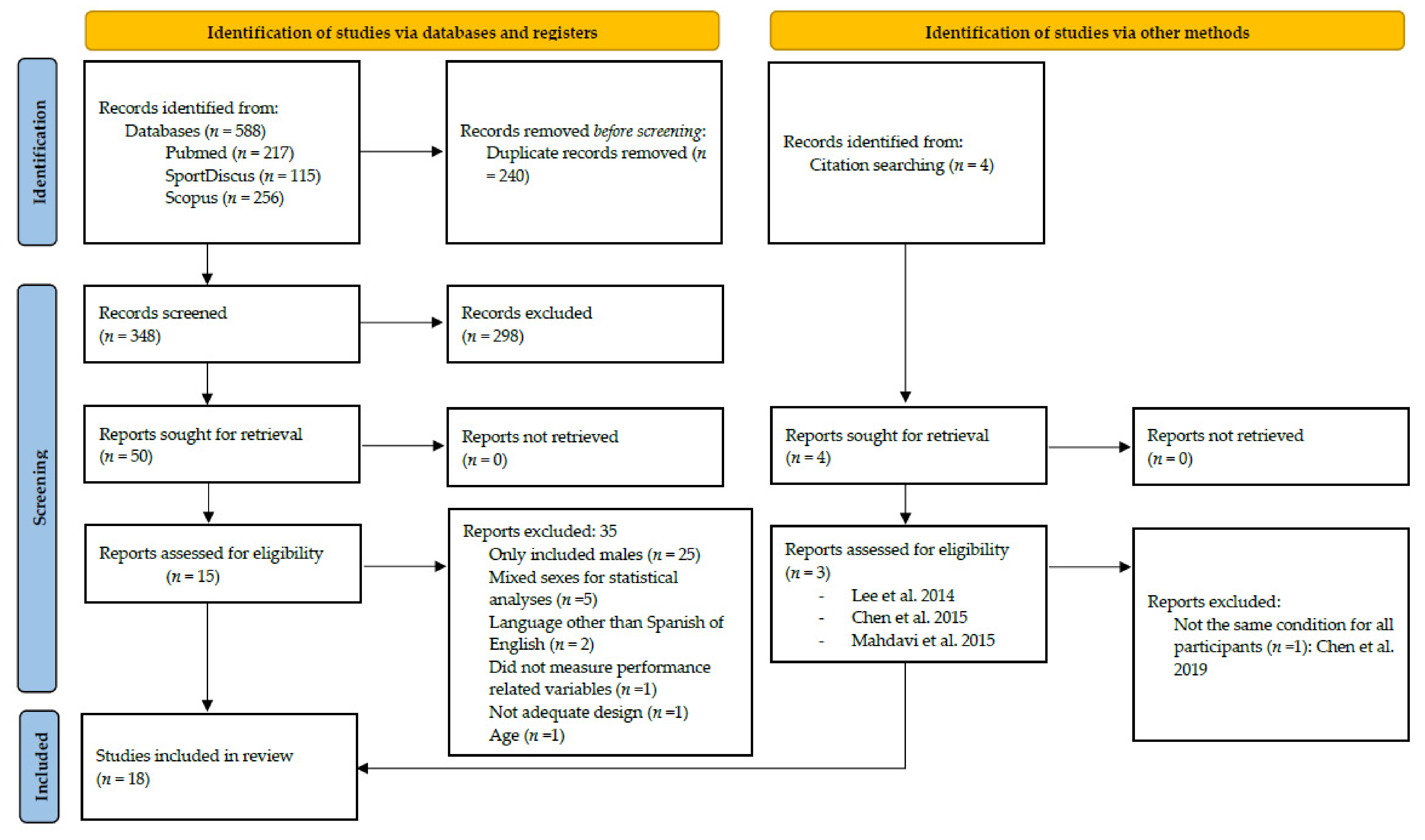
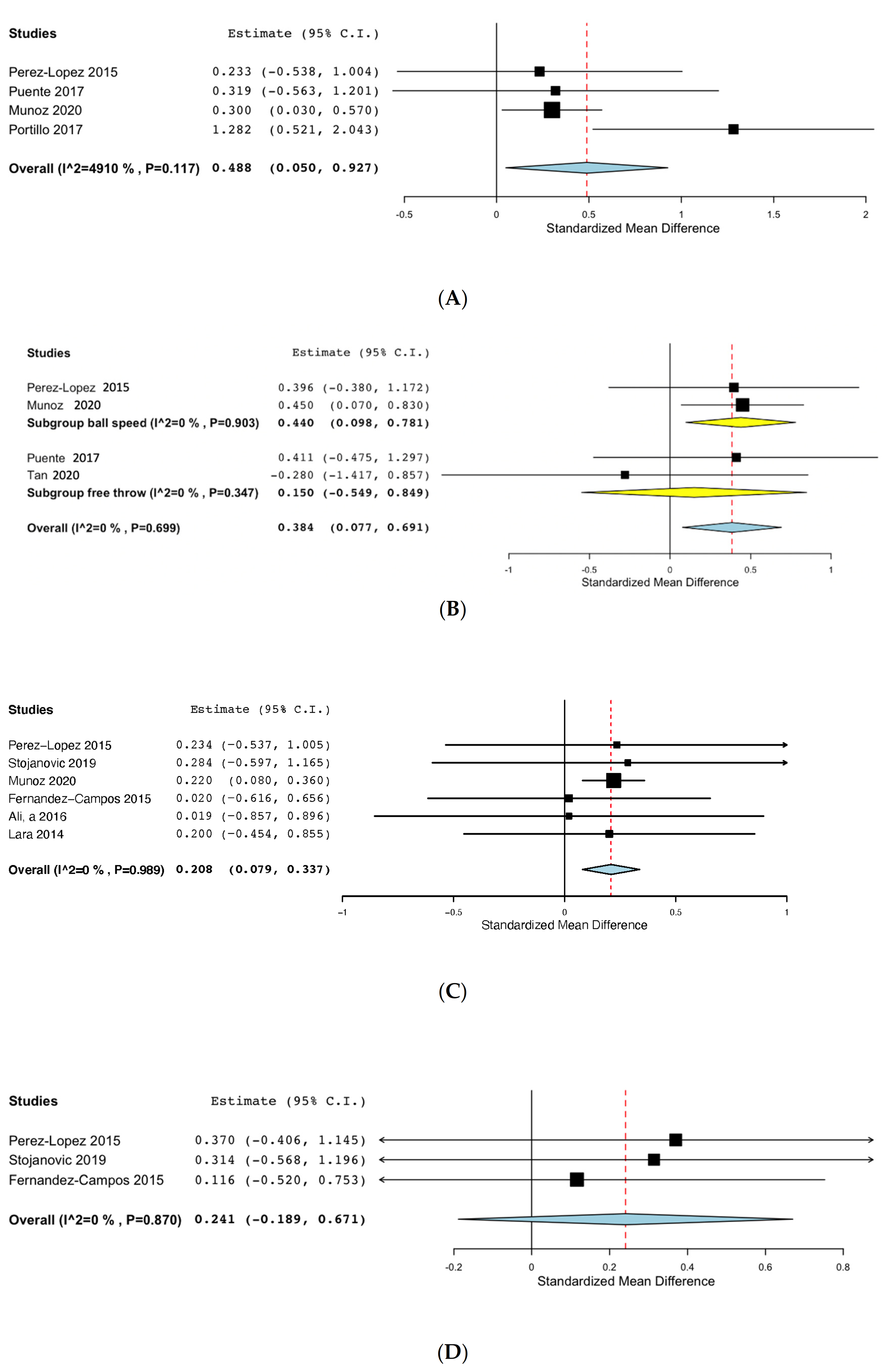
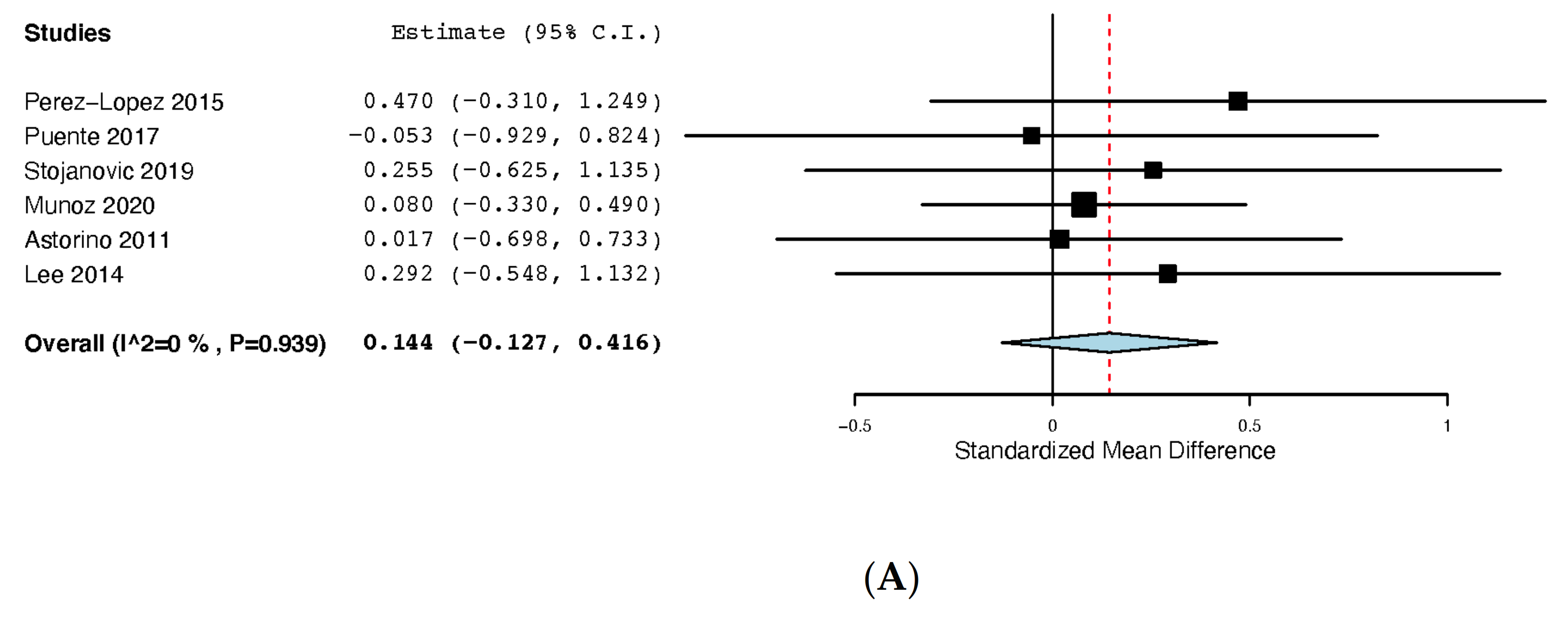
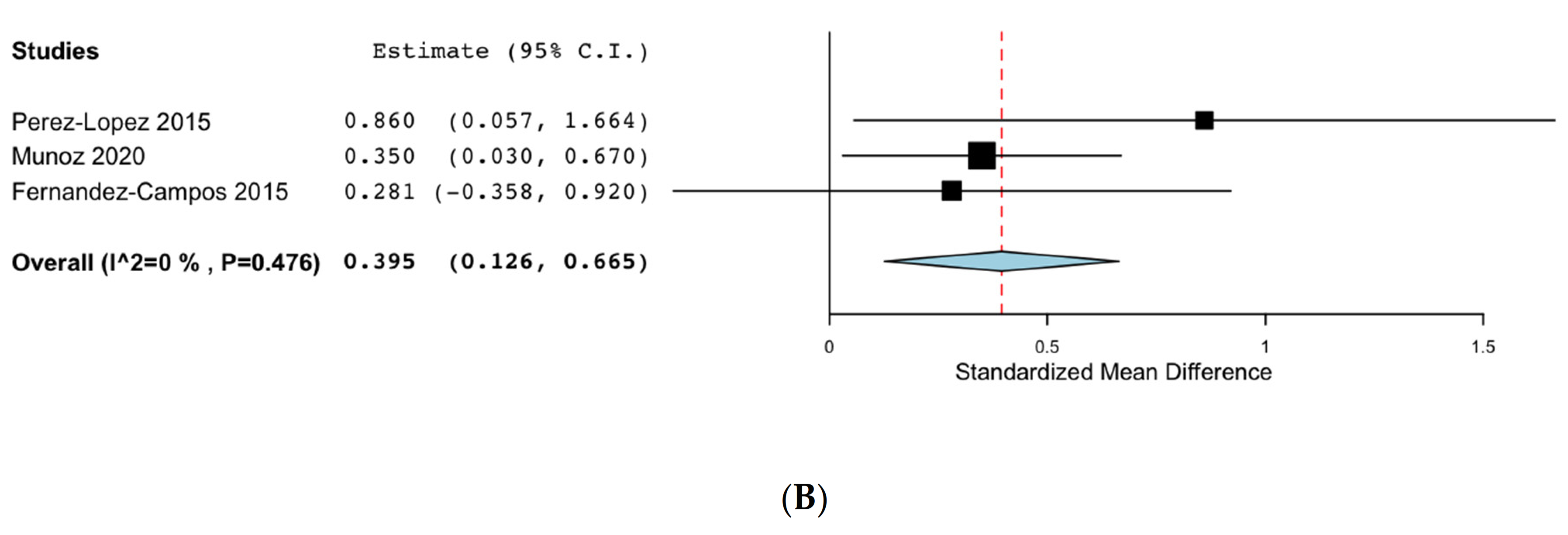
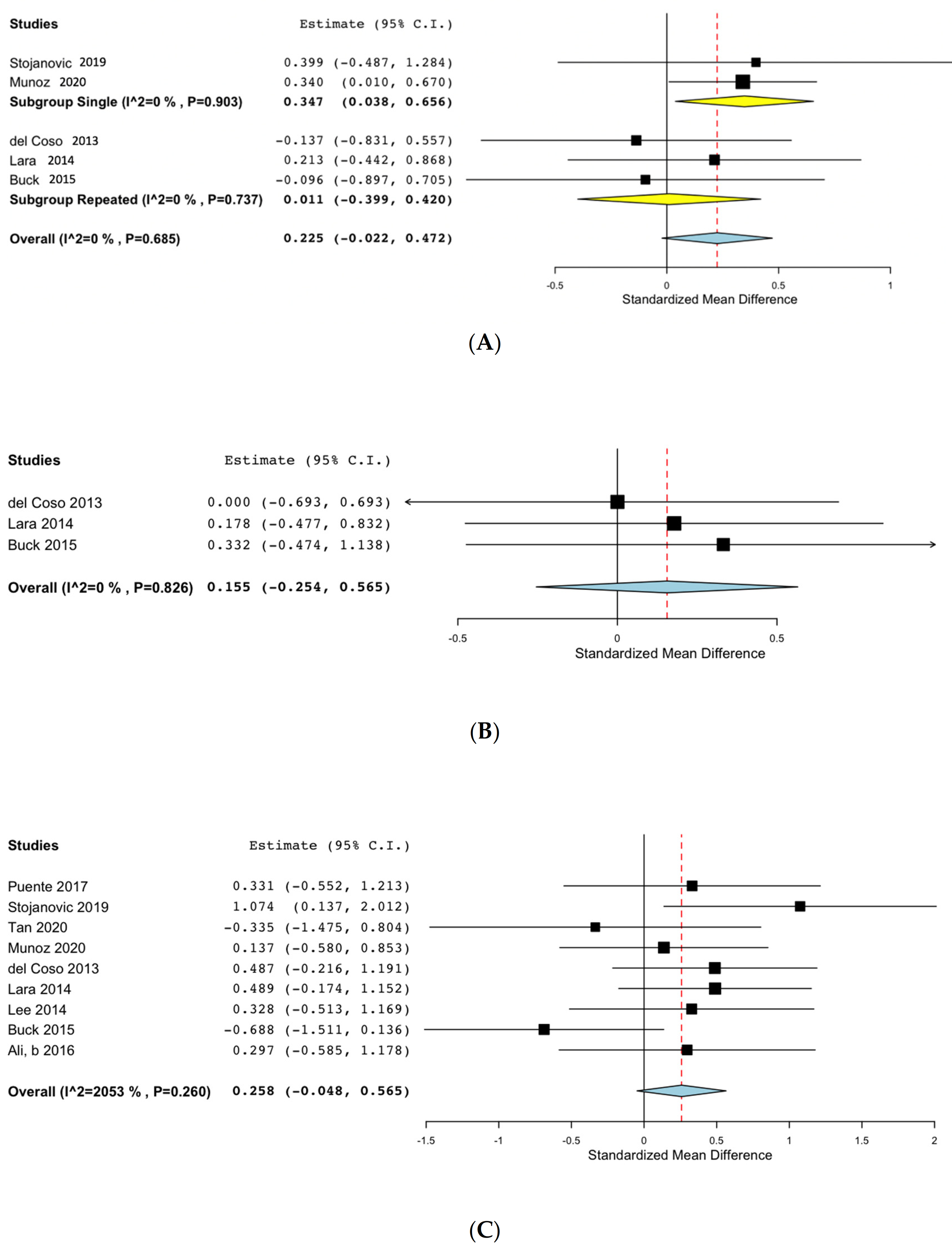

| Authors, Year, (Country) and PEDro Score | Sample Level + | Caffeine Consumption or Restrictions | Menstrual Cycle and Oral Contraceptives | Timing + Intervention + Washout | Sample State | Outcomes | R |
|---|---|---|---|---|---|---|---|
| Astorino et al. 2011 (USA) PEDro: 8/10 | 15 NAIA soccer players (19.5 ± 1.1 years) Level: semi-professional | 12/15 were caffeine consumers (dose not reported) Instructed not to ingest any caffeine 48 h before each trial | Not controlled | 60 min pre-test CAF: Red bull (80 mg: 1.3 mg/kg) PLA: Canada dry ginger ale Washout: 72–96 h | Rest | Agility t-test: Set 1/3 of 8 reps. | ⇄ |
| Fatigue | Agility t-test: Sets 2 and 3/3 of 8 reps | ⇄ | |||||
| RPE | ⇄ | ||||||
| Del Coso et al. 2013 (Spain) PEDro: 10/10 | 16 rugby sevens National Team (23 ± 2 years)Level: elite | Light caffeine consumers: <60 mg/day Encouraged to abstain from all dietary sources of caffeine for 48 h before | Not controlled | 60 min pre-test CAF: Powder caffeine-energy drink 3 mg/kg (Fure®) PLA: Powder drink 0 mg/kg Washout: 72 h | Rest | 6 × 30 m sprint test | ⇄ |
| Match | Distance covered walking | ⇄ | |||||
| Distance covered jogging | ⇄ | ||||||
| Distance covered cruising | ↑ | ||||||
| Distance covered striding | ↑ | ||||||
| Distance covered high intensity running | ↑ | ||||||
| Distance covered sprinting | ↑ | ||||||
| Match: RPE | ⇄ | ||||||
| Fatigue | 15 s maximal CMJs: total power | ↑ | |||||
| Lee et al. 2014 (Taiwan) PEDro: 10/10 | 11 Division I collegiate team-sport athletes (Basketball or Volleyball) (21.3 ± 1.2 years) Level: semi-professional | Light caffeine consumers: 50–100 mg/day | Not controlled | 60 min pre-test CAF: 6 mg/kg capsulesPLA: Cellulose capsules Washout: at least 1 week | Rest | Agility t-test | ⇄ |
| Fatigue | Cycle-ergometer repeated sprint peak power | ⇄ | |||||
| Cycle-ergometer repeated sprint mean power | ⇄ | ||||||
| Cycle-ergometer repeated sprint total work | ⇄ | ||||||
| Cycle-ergometer repeated sprint decrement | ⇄ | ||||||
| Agility t-test | ⇄ | ||||||
| Blood lactate | ↓ | ||||||
| RPE | ⇄ | ||||||
| Lara et al. 2014 (Spain) PEDro: 10/10 | 18 soccer players (21 ± 2 years) Level: not reported | Light caffeine consumers: not more than one cup of coffee or energy drink per day Encouraged to abstain from all dietary sources of caffeine for 48 h before | Not controlled | 60 min pre-test CAF: Powder caffeine-energy drink 3 mg/kg (Fure®) PLA: Powder drink 0 mg/kg Washout: 1 week | Rest | 7 × 30 m sprint average speed | ↑ |
| 7 × 30 m sprint maximal speed | ↑ | ||||||
| CMJ height | ↑ | ||||||
| CMJ Power | ⇄ | ||||||
| Match | Total distance covered | ↑ | |||||
| Time standing | ↑ | ||||||
| Time walking | ⇄ | ||||||
| Time running (3.1–8 km/h) | ↑ | ||||||
| Time running (8.1–13 km/h) | ↑ | ||||||
| Time running (13.1–18 km/h) | ⇄ | ||||||
| Time running (>18 km/h) | ↑ | ||||||
| Number of sprint bouts | ↑ | ||||||
| Maximal speed | ⇄ | ||||||
| RPE | ⇄ | ||||||
| Buck et al. 2015 (Australia) PEDro: 10/10 | 12 amateur team-sports (netball, basketball and soccer) (25.5 ± 1.9 years) Level: amateur | Caffeine consumption not reported Participants were advised to abstain from consuming CAF for 48 h prior to each trial | 3 days post (follicular phase) menstruation 9 were taking Levlen ED for birth control 3 took no oral contraceptives | 60 min pre-test CAF: Capsule (6 mg/kg BM) PLA: Capsule (1 g glucose) Washout: ≈21 days | Rest | 6 × 20 m sprint before PSM | ⇄ |
| Best 6 × 20 m sprint before PSM | ⇄ | ||||||
| Total 6 × 20 m sprint time before PSM | ⇄ | ||||||
| Fatigue | 6 × 20 m sprint half-time PSM | ⇄ | |||||
| 6 × 20 m sprint after PSM | ⇄ | ||||||
| Best 6 × 20 m sprint half-time PSM | ⇄ | ||||||
| Best 6 × 20 m sprint after PSM | ⇄ | ||||||
| Total 6 × 20 m sprint time half-time PSM | ⇄ | ||||||
| Total 6 × 20 m sprint time after PSM | ⇄ | ||||||
| RPE during and after PSM | ⇄ | ||||||
| Blood lactate during and after PSM | ⇄ | ||||||
| Chen et al. 2015 (Taiwan) PEDro: 10/10 | 10 elite collegiate athletes (tennis, soccer, basketball) (19.9 ± 0.9 years) Level: semi-professional | No regular caffeine consumption < 200 mg/week | Instructed to participate during their early follicular phase and avoid taking contraception | 60 min pre-test CAF: Capsule 6 mg/kg PLA: Diet flour in capsule Washout: 1 week | Rest | MVIC | ↑ |
| Isometric fatigue protocol | ↑ | ||||||
| Fatigue | Fatigued MVIC | ↑ | |||||
| Fatigue index | ↑ | ||||||
| Blood lactate | ↓ | ||||||
| Mahdavi et al. 2015 (Iran) PEDro: 10/10 | 24 basketball players (24.2 ± 2.6 years) Level: not reported | 116.8 ± 26.7 mg/day | Not controlled | 70 min pre-test CAF: Capsules 5 mg/kg PLA: Capsules with dextrose Washout: 1 week | Rest | 30 s WT: Peak power | ⇄ |
| 30 s WT: Mean power | ⇄ | ||||||
| 30 s WT: End power | ⇄ | ||||||
| 30 s WT: Power drop | ⇄ | ||||||
| 30 s WT: Fatigue index | ⇄ | ||||||
| 30 s WT: Lactate | ↑ | ||||||
| Fernandez-Campos et al. 2015 (Costa Rica) PEDro: 9/10 | 19 volleyball players from the elite league of Costa Rica (22.3 ± 4.9 years) Level: elite | Not reported | Not controlled | 30 min pre-test CAF: Energy drink 6 ml/kg with 73 mg of CAF in 273 mL. (1.7 mg/kg) PLA: flavored drink Washout: 1 week | Rest | Right handgrip strength | ↑ |
| Left handgrip strength | ⇄ | ||||||
| CMJ height | ⇄ | ||||||
| SJ height | ⇄ | ||||||
| WT peak power | ⇄ | ||||||
| WT mean power | ⇄ | ||||||
| WT fatigue index | ⇄ | ||||||
| Perez-Lopez et al. 2015 (Spain) PEDro: 10/10 | 13 volleyball players from the second division of the Spanish league (25.2 ± 4.8) Level: semi-professional | On the day of the trial participants were encouraged to refrain from all dietary sources of caffeine | 4 during follicular phase9 during luteal phase | 60 min pre-test CAF: Powder energy drink (Fure®) 3 mg/kg PLA: Powder with 0 mg/kg of CAF Washout: 1 week | Rest | Handgrip | ↑ |
| Spike jump height and peak power | ↑ | ||||||
| Block jump height and peak power | ↑ | ||||||
| Squat jump height and peak power | ↑ | ||||||
| CMJ height and peak power | ↑ | ||||||
| Agility t-test | ↑ | ||||||
| Standing spike ball velocity | ↑ | ||||||
| Jumping spike ball velocity | ↑ | ||||||
| Match | Body accelerations | ↑ | |||||
| Positive game actions | ↑ | ||||||
| Neutral game actions | ⇄ | ||||||
| Negative game actions | ↑ | ||||||
| Body impacts 0–1 g | ↑ | ||||||
| Body impacts 1.1–2 g | ↑ | ||||||
| Body impacts 2.1–3 g | ↑ | ||||||
| Body impacts 3.1–4 g | ⇄ | ||||||
| Body impacts 4.1–5 g | ↑ | ||||||
| Body impacts 5.1–6 g | ↑ | ||||||
| Ali et al. 2016a (New Zealand) PEDro: 10/10 | 10 healthy team sport players (soccer, hockey and netball) (24 ± 4 years) Level: amateur and elite | Self-reported daily caffeine intake varied from 0 to 300 mg/day | All participants were taking a monophasic oral contraceptive (Monofeme, Microgynon, Levlen ED or Nordette) | 60 min pre-test CAF: Capsules 6 mg/kg PLA: Capsules with artificial sweetener Washout: 13–17 days | Rest | Knee flexor ecc. PT pre-PSM | ⇄ |
| Knee extensor ecc. PT pre-PSM | ⇄ | ||||||
| Knee flexor ecc. Power pre-PSM | ⇄ | ||||||
| Knee extensor ecc. Power pre-PSM | ⇄ | ||||||
| Isometric knee flexor pre-PSM | ⇄ | ||||||
| Isometric knee extensor pre-PSM | ⇄ | ||||||
| CMJ height and power pre-PSM | ⇄ | ||||||
| Fatigue | Knee flexor ecc. PT mid-PSM | ↑ | |||||
| Knee flexor ecc. PT post-PSM | ⇄ | ||||||
| Knee flexor ecc. PT 12 h-post-PSM | ↑ | ||||||
| Knee extensor ecc. PT mid-PSM | ⇄ | ||||||
| Knee extensor ecc. PT post-PSM | ⇄ | ||||||
| Knee extensor ecc. PT 12 h-post-PSM | ⇄ | ||||||
| Knee flexor ecc. Power mid-PSM | ↑ | ||||||
| Knee flexor ecc. Power post-PSM | ⇄ | ||||||
| Knee flexor ecc. Power 12 h-post-PSM | ↑ | ||||||
| Knee extensor ecc. Power mid-PSM | ↑ | ||||||
| Knee extensor ecc. Power post-PSM | ⇄ | ||||||
| Knee extensor ecc. Power 12 h-post-PSM | ⇄ | ||||||
| Isometric knee flexor mid-PSM | ⇄ | ||||||
| Isometric knee flexor post-PSM | ⇄ | ||||||
| Isometric knee flexor 12 h post-PSM | ⇄ | ||||||
| Isometric knee extensor mid-PSM | ⇄ | ||||||
| Isometric knee extensor post-PSM | ⇄ | ||||||
| Isometric knee extensor 12 h post-PSM | ⇄ | ||||||
| CMJ height and power post-PSM | ⇄ | ||||||
| CMJ height and power 12 h post-PSM | ⇄ | ||||||
| Ali et al. 2016b (New Zealand) PEDro: 10/10 | 10 healthy team sport players (soccer, hockey and netball) (24 ± 4 years) Level: amateur and elite | Self-reported daily caffeine intake varied from 0 to 300 mg/day | All participants were taking a monophasic oralcontraceptive | 60 min pre-test CAF: Capsules 6 mg/kg PLA: Capsules with artificial sweetener Washout: 13–17 days | Fatigue | RPE | ⇄ |
| Portillo et al. 2017 (Spain) PEDro: 10/10 | 16 rugby sevens national team players (23 ± 2 years) Level: elite | Light caffeine consumers: <60 mg/day | Not controlled | 60 min pre-test CAF: Powder 3 mg/kg PLA: Powder with 0 mg/kg of CAF Washout: 72 h | Match | Body impacts 0–6 g | ↑ |
| Body impacts 6.01–6.5 g | ↑ | ||||||
| Body impacts 6.51–7 g | ↑ | ||||||
| Body impacts 7.01–8 g | ⇄ | ||||||
| Body impacts 8.01–10 g | ↑ | ||||||
| Body impacts > 10 g | ⇄ | ||||||
| Frequency of technical action | ⇄ | ||||||
| Ratings of skill performance | ⇄ | ||||||
| Puente et al. 2017 (Spain) PEDro: 10/10 | 10 professional basketaball players (27.9 ± 6.1 years) Level: semi-professional and elite | Light caffeine consumers < 100 mg/day Encouraged to abstain from CAF ingestion during the study | All participants were tested during their luteal phase | 60 min pre-test CAF: Capsule 3 mg/kgPLA: Capsule 0 mg/kg of CAF Washout: 1 week | Rest | Abalakov jump | NA |
| CODAT | |||||||
| Free throws | |||||||
| CODAT with ball | |||||||
| Match | Body impacts 0–0.99 g | ||||||
| Body impacts 1–1.99 g | |||||||
| Body impacts 2–2.99 g | |||||||
| Body impacts 3–3.99 g | |||||||
| Body impacts 4–4.99 g | |||||||
| Body impacts >5 g | |||||||
| RPE | |||||||
| Pfeifer et al. 2017 (USA) PEDro: 8/10 | 8 volleyball NAIA volleyball (18–22 years)Level: semi-professional | CAF consumption was not restricted | Not controlled | Prior to and during the competition CAF: PowerBar® PowerGel® 50 mg of caffeine. Averaged 1.39 mg/kg PLA: Non-nutritive gel Washout: ≈1 week | Fatigue | Vertical jump with a two-step approach | ⇄ |
| Three cone drill agility | ⇄ | ||||||
| 6 × 30 m sprint | ⇄ | ||||||
| Stojanovic et al. 2019 (Serbia) PEDro: 10/10 | 10 professional basketball players (20.2 ± 3.9 years) Level: elite | Light caffeine consumers: <100 mg/day | Completed testing in the luteal phase of their menstrual cycle Use of oral contraceptives not reported by authors | 60 min pre-test CAF: Capsule (3 mg/kg BM) PLA: Capsule (Dextrose) Washout: 1 week | Rest | CMJ height | ⇄ |
| SJ height | ⇄ | ||||||
| ABA height | ⇄ | ||||||
| Lane agility | ⇄ | ||||||
| 5 m sprint | ⇄ | ||||||
| 10 m sprint | ↑ | ||||||
| 20 m sprint | ↑ | ||||||
| 5 m sprint-dibbling | ⇄ | ||||||
| 10 m sprint-dibbling | ⇄ | ||||||
| 20 m sprint-dibbling | ⇄ | ||||||
| RSP: Suicide run | ⇄ | ||||||
| RPE | ↑ | ||||||
| Tan et al. 2020 (Singapore) PEDro: 8/10 | 6 basketball players Level: semi-professional | Less than 200 mg caffeine per day | Not controlled | 60 min pre-test CAF: Powders (6 mg/kg BM) PLA: Powders (Maltodextrine) Washout: 72 h | Fatigue | Free throws | NA |
| RPE | |||||||
| Muñoz et al. 2020 (Spain) PEDro: 10/10 | 15 elite handball players (22.6 ± 3.6 years) Level: elite | Light caffeine consumers: 50 ± 30 mg/day | 10 during follicular phase 5 during luteal phase Use of oral contraceptives not reported by authors | 60 min pre-test CAF: Capsule (3 mg/kg BM) PLA: Capsule (Cellulose) Washout: 1 week | Rest | 7m ball throws | ↑ |
| 9m ball throws | ↑ | ||||||
| 7m ball throws goalk. | ↑ | ||||||
| 9m ball throws goalk. | ↑ | ||||||
| CMJ height | ↑ | ||||||
| Handgrip | ↑ | ||||||
| Agility: MATT | ⇄ | ||||||
| 30m sprint | ↑ | ||||||
| Match | Accelerations frequency | ↑ | |||||
| Decelerations frequency | ↑ | ||||||
| Body impacts | ↑ | ||||||
| Total distance | ⇄ | ||||||
| Sprint distance | ⇄ | ||||||
| Maximal speed | ⇄ | ||||||
| RPE | ⇄ | ||||||
| Karayigit et al. 2021 (Turkey) PEDro: 10/10 | 17 female team sports (rugby, handball and soccer) 23 ± 2 years) Level: elite and semi-professional | Light caffeine consumers: <25 mg/day | All sessions were performed during the luteal phase of the menstrual cycle All subjects stopped oral contraceptive consumpletion 3 months before the commencement of the study | 60 min pre-test CAF: Coffee (3 mg/kg BM) (6 mg/kg BM) PLA: Decaffeinated coffee Washout: 48–72 h | Rest | 3 set of repetitions to failure 40% 1 RM bench press | ↑ |
| 3 set of repetitions to failure 40% 1 RM squat | ⇄ |
Publisher’s Note: MDPI stays neutral with regard to jurisdictional claims in published maps and institutional affiliations. |
© 2021 by the authors. Licensee MDPI, Basel, Switzerland. This article is an open access article distributed under the terms and conditions of the Creative Commons Attribution (CC BY) license (https://creativecommons.org/licenses/by/4.0/).
Share and Cite
Gomez-Bruton, A.; Marin-Puyalto, J.; Muñiz-Pardos, B.; Matute-Llorente, A.; Del Coso, J.; Gomez-Cabello, A.; Vicente-Rodriguez, G.; Casajus, J.A.; Lozano-Berges, G. Does Acute Caffeine Supplementation Improve Physical Performance in Female Team-Sport Athletes? Evidence from a Systematic Review and Meta-Analysis. Nutrients 2021, 13, 3663. https://doi.org/10.3390/nu13103663
Gomez-Bruton A, Marin-Puyalto J, Muñiz-Pardos B, Matute-Llorente A, Del Coso J, Gomez-Cabello A, Vicente-Rodriguez G, Casajus JA, Lozano-Berges G. Does Acute Caffeine Supplementation Improve Physical Performance in Female Team-Sport Athletes? Evidence from a Systematic Review and Meta-Analysis. Nutrients. 2021; 13(10):3663. https://doi.org/10.3390/nu13103663
Chicago/Turabian StyleGomez-Bruton, Alejandro, Jorge Marin-Puyalto, Borja Muñiz-Pardos, Angel Matute-Llorente, Juan Del Coso, Alba Gomez-Cabello, German Vicente-Rodriguez, Jose A. Casajus, and Gabriel Lozano-Berges. 2021. "Does Acute Caffeine Supplementation Improve Physical Performance in Female Team-Sport Athletes? Evidence from a Systematic Review and Meta-Analysis" Nutrients 13, no. 10: 3663. https://doi.org/10.3390/nu13103663
APA StyleGomez-Bruton, A., Marin-Puyalto, J., Muñiz-Pardos, B., Matute-Llorente, A., Del Coso, J., Gomez-Cabello, A., Vicente-Rodriguez, G., Casajus, J. A., & Lozano-Berges, G. (2021). Does Acute Caffeine Supplementation Improve Physical Performance in Female Team-Sport Athletes? Evidence from a Systematic Review and Meta-Analysis. Nutrients, 13(10), 3663. https://doi.org/10.3390/nu13103663











